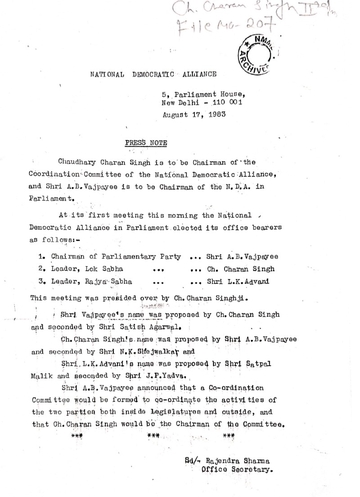This document provides detailed information about the formation of the National Democratic Alliance (NDA) in India in August 1983, primarily involving the Bharatiya Janata Party (BJP) and the Lok Dal. This alliance was a significant political development aimed at strengthening the opposition against the ruling Congress (I) party.
The NDA was officially announced on August 17, 1983, with Chaudhary Charan Singh appointed as the Chairman of the Coordination Committee and A.B. Vajpayee as the Chairman of the NDA in Parliament. The alliance was presented as a major step towards strengthening democracy in India, with both parties emphasizing the need for a strong opposition to counter the perceived failures of the Congress (I) government.
It highlights the strategic importance of this alliance, particularly in the Hindi heartland states such as Uttar Pradesh, Madhya Pradesh, Bihar, and Haryana. The alliance was not intended as a merger but as a coordinated effort to work together in Parliament, state legislatures, and outside the political arena.
The formation of the NDA was met with mixed reactions from other political entities. The Communist Party of India (Marxist) adopted a wait-and-watch approach, while some members of the Janata Party expressed disappointment, viewing the alliance as potentially isolating both the Lok Dal and BJP. It also mentions efforts to expand the alliance to include other "like-minded" parties, though specifically excluding communist parties.
Internal discussions within the BJP, as evidenced by their national executive meeting in Patna, show that while the party endorsed the alliance, there was caution about an immediate merger. The party leadership emphasized the need to analyze the alliance's effectiveness before considering further steps.
The document also reveals some of the challenges faced by the alliance, including skepticism from within the Lok Dal ranks. Some prominent Lok Dal leaders expressed concerns about aligning with the BJP, fearing it might erode their traditional support base, particularly among backward classes and agricultural communities.


